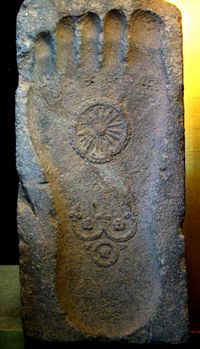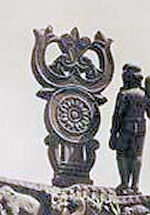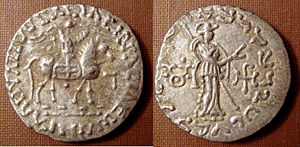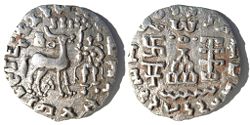Difference between revisions of "Three Jewels" - New World Encyclopedia
Scott Dunbar (talk | contribs) m (→"Diamond Mind") |
Rosie Tanabe (talk | contribs) |
||
| (25 intermediate revisions by 4 users not shown) | |||
| Line 1: | Line 1: | ||
| − | {{ready}} | + | {{Copyedited}}{{Approved}}{{Submitted}}{{Images OK}}{{ready}} |
| − | [[Image:TriratnaSymbol.jpg|thumb|200px|Symbol of the triratna, as seen in the [[Sanchi|Sanchi stupa]], | + | [[Image:TriratnaSymbol.jpg|thumb|200px|Symbol of the triratna, as seen in the [[Sanchi|Sanchi stupa]], first century B.C.E.]] |
| − | The '''Three Jewels''' (also called the '''Three Treasures''' or '''Triple Gem''') are three vows that | + | The '''Three Jewels''' (also called the '''Three Treasures''' or '''Triple Gem''') are three religious vows that are made in the process of becoming a [[Buddhism|Buddhist]]. The Buddhist cermonies of ordination, called "Taking refuge," involve three pledges, which are as follows: |
* ''I take refuge in the Buddha'' ("The Enlightened" or "Awakened One"), who, depending on one's interpretation, can mean the Historical Buddha, [[Buddha|Shakyamuni]], or the Buddha nature or ideal within all beings; | * ''I take refuge in the Buddha'' ("The Enlightened" or "Awakened One"), who, depending on one's interpretation, can mean the Historical Buddha, [[Buddha|Shakyamuni]], or the Buddha nature or ideal within all beings; | ||
* ''I take refuge in the Dharma'' (The "Teachings") | * ''I take refuge in the Dharma'' (The "Teachings") | ||
* ''I take refuge in the Sangha'' (The "Community") | * ''I take refuge in the Sangha'' (The "Community") | ||
| − | + | {{toc}} | |
Taking refuge in these "Triple Jewels" is generally considered to make one officially a Buddhist. These three vows are central to both Buddhist lay and monastic ordination ceremonies, as initiated by [[Buddha|Gautama Buddha]] himself. | Taking refuge in these "Triple Jewels" is generally considered to make one officially a Buddhist. These three vows are central to both Buddhist lay and monastic ordination ceremonies, as initiated by [[Buddha|Gautama Buddha]] himself. | ||
| Line 62: | Line 62: | ||
*བདག་གིས་སྦྱིན་སོགས་བགྱིྱིས་པའི་བསོད་ནམས་ཀྱིས། | *བདག་གིས་སྦྱིན་སོགས་བགྱིྱིས་པའི་བསོད་ནམས་ཀྱིས། | ||
Dag-gi jin-sog gyi-pe so-nam-kyi<BR> | Dag-gi jin-sog gyi-pe so-nam-kyi<BR> | ||
| − | By the merit I have accumulated from practicing generosity and the other perfections | + | By the merit I have accumulated from practicing generosity and the other perfections. |
*འགྲྲོ་ལ་ཕན་ཕྱིར་སངས་རྒྱས་འགྲྲུབ་པར་ཤོག །། | *འགྲྲོ་ལ་ཕན་ཕྱིར་སངས་རྒྱས་འགྲྲུབ་པར་ཤོག །། | ||
| Line 70: | Line 70: | ||
</table> | </table> | ||
| − | + | [[Image:Buddha-Footprint.jpeg|thumb|200px|The ''Triratna'' or "Three Jewels" symbol, on a Buddha footprint (bottom symbol, the top symbol being a dharmachakra). First century C.E., [[Gandhara]].]] | |
| − | [[Image:Buddha-Footprint.jpeg|thumb|200px|The ''Triratna'' or "Three Jewels" symbol, on a Buddha footprint (bottom symbol, the top symbol being a dharmachakra). | ||
==Discussions of The Three Jewels== | ==Discussions of The Three Jewels== | ||
The qualities of the Buddha, Dharma, and Sangha are frequently repeated in the ancient texts and are called "Mirror of the Dhamma" or "Dhamma Adassa." | The qualities of the Buddha, Dharma, and Sangha are frequently repeated in the ancient texts and are called "Mirror of the Dhamma" or "Dhamma Adassa." | ||
| − | * '''The Buddha:''' "The Blessed One is an [[arhat|Arahant]], perfectly enlightened, accomplished in true knowledge and conduct, fortunate, knower of the world, unsurpassed leader of persons to be tamed, teacher of devas and humans, the Enlightened One, the Blessed One."<ref> Bodhi | + | * '''The Buddha:''' "The Blessed One is an [[arhat|Arahant]], perfectly enlightened, accomplished in true knowledge and conduct, fortunate, knower of the world, unsurpassed leader of persons to be tamed, teacher of devas and humans, the Enlightened One, the Blessed One."<ref> Bhikkhu Bodhi, ''The Connected Discourses of the Buddha A New Translation of the Saṃyutta Nikāya'', Translated from the Pāli (Somerville, MA: Wisdom Publications, 2000, ISBN 9780861711895).</ref> |
| − | Sometimes ''the Buddha as refuge'' is taken to refer to the historical Buddha and also 'the full development of mind', in other words, the full development of one's highest potential, i.e. recognition of mind and the completion or full development of one's inherent qualities and activities. In this context, the Triple Gem is in the | + | Sometimes ''the Buddha as refuge'' is taken to refer to the historical Buddha and also 'the full development of mind', in other words, the full development of one's highest potential, i.e. recognition of mind and the completion or full development of one's inherent qualities and activities. In this context, the Triple Gem is in the center of one of the major practices of mental "reflection" in Buddhism; the reflection on the true qualities of the [[Buddha]], Dharma and [[Sangha]]. These qualities are called the ''Mirror of the Dharma'' in the ''Mahaparinibbana Sutta'' and help the practitioner attain the true "mind like a mirror." |
* '''The Dharma:''' Refuge in the Dharma, in the [[Vajrayana]], tradition includes reference not only to the words of the Buddha, but to the living experience of realization and teachings of fully realized practitioners. In [[Tibetan Buddhism]], it includes both the [[Kangyur]] (the teaching of the Buddha) and the [[Tengyur]] (the commentaries by realized practitioners) and in an intangible way also includes the living transmission of those masters, which can also be very inspiring. | * '''The Dharma:''' Refuge in the Dharma, in the [[Vajrayana]], tradition includes reference not only to the words of the Buddha, but to the living experience of realization and teachings of fully realized practitioners. In [[Tibetan Buddhism]], it includes both the [[Kangyur]] (the teaching of the Buddha) and the [[Tengyur]] (the commentaries by realized practitioners) and in an intangible way also includes the living transmission of those masters, which can also be very inspiring. | ||
| Line 97: | Line 96: | ||
<blockquote> | <blockquote> | ||
| − | The outer three jewels are the Buddha, Dharma, and Sangha. The Three jewels have an inner aspect, known as the Three Roots: the Guru (or Teacher), who is the root of blessings; the Yidam, who is the root of accomplishment; and the Dakini, who is the root of enlightened activity. Although the names are different, these three do not in any way differ from the Three Jewels. The Guru is the Budha [''sic''], the Yidam is the Dharma, and the Dakinis and Protectors are the Sangha. And on the innermost level, the Dharmakaya is the Buddha, the Sambhogakaya is the Dharma, and the Nirmanakaya is the Sangha.<ref> | + | The outer three jewels are the Buddha, Dharma, and Sangha. The Three jewels have an inner aspect, known as the Three Roots: the Guru (or Teacher), who is the root of blessings; the Yidam, who is the root of accomplishment; and the Dakini, who is the root of enlightened activity. Although the names are different, these three do not in any way differ from the Three Jewels. The Guru is the Budha [''sic''], the Yidam is the Dharma, and the Dakinis and Protectors are the Sangha. And on the innermost level, the Dharmakaya is the Buddha, the Sambhogakaya is the Dharma, and the Nirmanakaya is the Sangha.<ref>Reginald A. Ray, ''In the Presence of Masters Wisdom from 30 Contemporary Tibetan Buddhist Teachers'' (Boston: Shambhala, 2004, ISBN 781570628498).</ref> |
</blockquote> | </blockquote> | ||
| Line 106: | Line 105: | ||
The ''Three Gems'' when used in the process of taking refuge, become the ''Three Refuges''. In this form, the metaphors occur very frequently in the ancient Buddhist Texts, and here the Sangha is used more broadly to refer to either the Sangha of Bhikkhus, or the Sangha of Bhikkhunis. | The ''Three Gems'' when used in the process of taking refuge, become the ''Three Refuges''. In this form, the metaphors occur very frequently in the ancient Buddhist Texts, and here the Sangha is used more broadly to refer to either the Sangha of Bhikkhus, or the Sangha of Bhikkhunis. | ||
| − | <center>"I go to Master Gotama for refuge and to the Dhamma, and to the Sangha of Bhikkhus."<ref> Ñāṇamoli | + | <center>"I go to Master Gotama for refuge and to the Dhamma, and to the Sangha of Bhikkhus."<ref> Ñāṇamoli and Bodhi, ''The middle length discourses of the Buddha a new translation of the Majjhima Nikāya. Teachings of the Buddha'' (Oxford: Pali Text Society in Association with Wisdom Publications, 2001, ISBN 9780860134008).</ref></center> |
=== "Diamond Mind" === | === "Diamond Mind" === | ||
| Line 114: | Line 113: | ||
=== "Gems" in the Ratana-sutta === | === "Gems" in the Ratana-sutta === | ||
| − | The expression ''Three Gems'' are found in the earliest Buddhist literature of the [[Pali Canon]], besides other works there is one sutta in the Sutta-nipata, called the ''Ratana-sutta''<ref>Andersen | + | The expression ''Three Gems'' are found in the earliest Buddhist literature of the [[Pali Canon]], besides other works there is one sutta in the Sutta-nipata, called the ''Ratana-sutta''<ref>Dines Andersen and Helmer Smith, ''The Sutta-nipāta'' (London: published for the Pali Text Society by Luzac, 1965, OCLC 3336548).</ref> which contains a series of verses on the Jewels in the [[Buddha]], Dharma, and [[Sangha]]. |
In the ''Ratana-sutta'', all the qualities of the Sangha mentioned are attributes of the Buddha's enlightened disciples: | In the ''Ratana-sutta'', all the qualities of the Sangha mentioned are attributes of the Buddha's enlightened disciples: | ||
| Line 122: | Line 121: | ||
=== Used as a metaphor with Jainism and Taoism === | === Used as a metaphor with Jainism and Taoism === | ||
| − | In Buddhism, the "Triple Gem" is not a metaphor and actually the initiation into the Dhamma that every Buddhist must take. However, it is used metaphorically in [[Jainism]] and [[Taoism]]. When Buddhism was introduced into China, ''ratnatraya'' was translated as ''sanbao'' ({{zh-cpwl|c=三寶|p=''sānbǎo''| w=''san-pao''|l=three jewels/treasures}}), a word that first occurs in the ''[[Dao De Jing]]''. | + | In Buddhism, the "Triple Gem" is not a [[metaphor]] and actually the initiation into the Dhamma that every Buddhist must take. However, it is used metaphorically in [[Jainism]] and [[Taoism]]. When Buddhism was introduced into [[China]], ''ratnatraya'' was translated as ''sanbao'' ({{zh-cpwl|c=三寶|p=''sānbǎo''| w=''san-pao''|l=three jewels/treasures}}), a word that first occurs in the ''[[Dao De Jing]]''. |
| − | In his analysis of the ''Tao Te Ching'', Victor H. Mair notes<ref>Laozi | + | In his analysis of the ''Tao Te Ching'', Victor H. Mair notes<ref>Laozi and Victor H. Mair, ''Tao Te Ching The Classic Book of Integrity and the Way'' (New York: Bantam Books, 1990, ISBN 9780553349351).</ref> that the jewel metaphor was already widely used in Indian religious metaphor before the ''Tao Te Ching'' was written. In Jainism too, |
For the Jains, the Three Jewels are a metaphor for describing conduct and knowledge: | For the Jains, the Three Jewels are a metaphor for describing conduct and knowledge: | ||
| Line 132: | Line 131: | ||
== Symbolism in Art == | == Symbolism in Art == | ||
| − | [[Image:SanchiGateSymbol.jpg|150px|thumb| | + | [[Image:SanchiGateSymbol.jpg|150px|thumb|left|The compound Buddhist symbols: Shrivatsa within a triratana, over a Dharmacakra wheel, on the Torana gate at [[Sanchi]]. First century B.C.E.]] |
The ''Three Jewels'' are also symbolized by the ''triratna'', composed of (from bottom to top): | The ''Three Jewels'' are also symbolized by the ''triratna'', composed of (from bottom to top): | ||
| Line 142: | Line 141: | ||
On representations of the footprint of the Buddha, the Triratna is usually also surmounted by the Dharma wheel. | On representations of the footprint of the Buddha, the Triratna is usually also surmounted by the Dharma wheel. | ||
| − | The Triratna can be found on frieze sculptures at [[Sanchi]] as the symbol crowning a flag standard ( | + | The Triratna can be found on frieze sculptures at [[Sanchi]] as the symbol crowning a flag standard (second century B.C.E.), as a symbol of the Buddha installed on the Buddha's throne (second century B.C.E.), as the crowning decorative symbol on the later gates at the [[stupa]] in Sanchi (2nd century C.E.), or, very often on the Buddha footprint (starting from the first century C.E.). |
| − | [[Image:KunindaCoin.JPG|thumb|250px| | + | [[Image:KunindaCoin.JPG|thumb|250px|Second century B.C.E. coin of the Kunindas, incorporating on the reverse the Buddhist triratna symbol on top of a stupa.]] |
| − | The Triratna is also on the | + | The Triratna is also on the first century B.C.E. coins of the Kingdom of Kuninda in northern [[Punjab]], surmounting depictions of stupas, on some the coins of the Indo-Parthian king Abdagases, or the coins of some of the Kushan kings such as Vima Kadphises. |
The triratna can be further reinforced by being surmounted with three dharma wheels (one for each of the three jewels of Buddhism: the [[Buddha]], the Dharma and the [[Sangha]]). | The triratna can be further reinforced by being surmounted with three dharma wheels (one for each of the three jewels of Buddhism: the [[Buddha]], the Dharma and the [[Sangha]]). | ||
| Line 157: | Line 156: | ||
==References== | ==References== | ||
| − | * Bodhi, Bhikkhu. ''The Connected Discourses of the Buddha A New Translation of the Saṃyutta Nikāya.'' Somerville, MA: Wisdom Publications, 2000. ISBN 9780861711895 | + | * Bodhi, Bhikkhu. ''The Connected Discourses of the Buddha A New Translation of the Saṃyutta Nikāya.'' Somerville, MA: Wisdom Publications, 2000. ISBN 9780861711895 |
| − | *Laozi, and Victor H. Mair. Tao Te Ching The Classic Book of Integrity and the Way. New York: Bantam Books, 1990. ISBN 9780553349351 | + | *Laozi, and Victor H. Mair. Tao Te Ching The Classic Book of Integrity and the Way. New York: Bantam Books, 1990. ISBN 9780553349351 |
| − | *Ñāṇamoli, and Bodhi. ''The middle length discourses of the Buddha a new translation of the Majjhima Nikāya. Teachings of the Buddha.'' Oxford: Pali Text Society in Association with Wisdom Publications, 2001. ISBN 9780860134008 | + | *Ñāṇamoli, and Bodhi. ''The middle length discourses of the Buddha a new translation of the Majjhima Nikāya. Teachings of the Buddha.'' Oxford: Pali Text Society in Association with Wisdom Publications, 2001. ISBN 9780860134008 |
| − | *Ray, Reginald A. ''In the Presence of Masters Wisdom from 30 Contemporary Tibetan Buddhist Teachers.'' Boston: Shambhala, 2004. ISBN | + | *Ray, Reginald A. ''In the Presence of Masters Wisdom from 30 Contemporary Tibetan Buddhist Teachers.'' Boston: Shambhala, 2004. ISBN 978-1570628498 |
==External links== | ==External links== | ||
| − | All links retrieved | + | All links retrieved April 30, 2023. |
*[http://www.onmarkproductions.com/html/footprints-bussokuseki.html Triratna on the footprints of the Buddha] | *[http://www.onmarkproductions.com/html/footprints-bussokuseki.html Triratna on the footprints of the Buddha] | ||
*[http://www.columbia.edu/itc/mealac/pritchett/00routesdata/0100_0199/kushanart/buddhapada/buddhapada.html Buddhapada and Triratna] | *[http://www.columbia.edu/itc/mealac/pritchett/00routesdata/0100_0199/kushanart/buddhapada/buddhapada.html Buddhapada and Triratna] | ||
| − | *[http://www.miho.or.jp/booth/html/imgbig/00001179e.htm Another triratna on Buddha's footprint | + | *[http://www.miho.or.jp/booth/html/imgbig/00001179e.htm Another triratna on Buddha's footprint] |
*[http://www.buddhanet.net/filelib/mp3/03-chant-03.mp3 Chanting of Pali text by Ven. Indaratana Maha Thera] | *[http://www.buddhanet.net/filelib/mp3/03-chant-03.mp3 Chanting of Pali text by Ven. Indaratana Maha Thera] | ||
| − | |||
[[Category:Philosophy and religion]] | [[Category:Philosophy and religion]] | ||
Latest revision as of 23:03, 30 April 2023

The Three Jewels (also called the Three Treasures or Triple Gem) are three religious vows that are made in the process of becoming a Buddhist. The Buddhist cermonies of ordination, called "Taking refuge," involve three pledges, which are as follows:
- I take refuge in the Buddha ("The Enlightened" or "Awakened One"), who, depending on one's interpretation, can mean the Historical Buddha, Shakyamuni, or the Buddha nature or ideal within all beings;
- I take refuge in the Dharma (The "Teachings")
- I take refuge in the Sangha (The "Community")
Taking refuge in these "Triple Jewels" is generally considered to make one officially a Buddhist. These three vows are central to both Buddhist lay and monastic ordination ceremonies, as initiated by Gautama Buddha himself.
Refuge Formula
The following Pali chant, known as the Vandana Ti-sarana, is often recited by both monks and lay people in many Theravada Buddhist communities:
|
The Mahayana Chinese/Japanese version differs only slightly from the Theravada:
|
The prayer for taking refuge in Tibetan Buddhism.
|

Discussions of The Three Jewels
The qualities of the Buddha, Dharma, and Sangha are frequently repeated in the ancient texts and are called "Mirror of the Dhamma" or "Dhamma Adassa."
- The Buddha: "The Blessed One is an Arahant, perfectly enlightened, accomplished in true knowledge and conduct, fortunate, knower of the world, unsurpassed leader of persons to be tamed, teacher of devas and humans, the Enlightened One, the Blessed One."[1]
Sometimes the Buddha as refuge is taken to refer to the historical Buddha and also 'the full development of mind', in other words, the full development of one's highest potential, i.e. recognition of mind and the completion or full development of one's inherent qualities and activities. In this context, the Triple Gem is in the center of one of the major practices of mental "reflection" in Buddhism; the reflection on the true qualities of the Buddha, Dharma and Sangha. These qualities are called the Mirror of the Dharma in the Mahaparinibbana Sutta and help the practitioner attain the true "mind like a mirror."
- The Dharma: Refuge in the Dharma, in the Vajrayana, tradition includes reference not only to the words of the Buddha, but to the living experience of realization and teachings of fully realized practitioners. In Tibetan Buddhism, it includes both the Kangyur (the teaching of the Buddha) and the Tengyur (the commentaries by realized practitioners) and in an intangible way also includes the living transmission of those masters, which can also be very inspiring.
- The Sangha: In the Vajrayana, a more liberal definition of Sangha can include all practitioners who are actively using the Buddha's teachings to benefit themselves and/or others. It can be more strictly defined as the 'Realized Sangha' or 'Arya-Sangha', in other words, practitioners and historical students of the Buddha who have fully realized the nature of their mind, also known as realized Boddhisatvas; and 'Ordinary Sangha', which can loosely mean practitioners and students of the Buddha who are using the same methods and working towards the same goal.
The Three Jewels and The Three Roots
In Vajrayana traditions, a second formulation of refuge called the "Three Roots" is added to the three jewels. They are
- the Guru, considered the "Root of Blessing"
- the Yidam, which is the "Root of Methods"
- Dakini or Dharmapalas, considered the "Root of Protection"
These are seen as forms of the Body (Sangha), Speech (Dharma) and Mind (Buddha) of the Buddha. Of these, the guru has the most prominent place in the Vajrayana, as without his personal assistance and guidance, a practitioner cannot achieve proper spiritual progress.
Dilgo Khyentse Rinpoche discusses the "Twilight Language" equivalences and polyvalence of the Outer, Inner and Secret aspects of the Three Jewels:
The outer three jewels are the Buddha, Dharma, and Sangha. The Three jewels have an inner aspect, known as the Three Roots: the Guru (or Teacher), who is the root of blessings; the Yidam, who is the root of accomplishment; and the Dakini, who is the root of enlightened activity. Although the names are different, these three do not in any way differ from the Three Jewels. The Guru is the Budha [sic], the Yidam is the Dharma, and the Dakinis and Protectors are the Sangha. And on the innermost level, the Dharmakaya is the Buddha, the Sambhogakaya is the Dharma, and the Nirmanakaya is the Sangha.[2]
History of the Triple Gem Metaphor
The three gems are so called because of their treasured value to Buddhists as well as their indestructible and unchanging nature.
The Three Gems when used in the process of taking refuge, become the Three Refuges. In this form, the metaphors occur very frequently in the ancient Buddhist Texts, and here the Sangha is used more broadly to refer to either the Sangha of Bhikkhus, or the Sangha of Bhikkhunis.
"Diamond Mind"
Buddha's mind in his earth body or sambhogakaya is frequently associated with the greatest gem of all, the diamond, the hardest natural substance. In the Anguttara Nikaya (3:25), Buddha talks about the diamond mind, which can cut through all delusion.
"Gems" in the Ratana-sutta
The expression Three Gems are found in the earliest Buddhist literature of the Pali Canon, besides other works there is one sutta in the Sutta-nipata, called the Ratana-sutta[4] which contains a series of verses on the Jewels in the Buddha, Dharma, and Sangha.
In the Ratana-sutta, all the qualities of the Sangha mentioned are attributes of the Buddha's enlightened disciples:
- One who is irascible and very irritable, displaying anger, hatred and sulkiness; such a one is said to be a person with a mind like an open sore.
- One who understands the "Four Noble Truths" correctly is said to have a mind like a flash of lightning.
- One who has destroyed the mind-intoxicating defilements and realized the liberation of mind and the liberation by knowledge is said to have a mind like a diamond
Used as a metaphor with Jainism and Taoism
In Buddhism, the "Triple Gem" is not a metaphor and actually the initiation into the Dhamma that every Buddhist must take. However, it is used metaphorically in Jainism and Taoism. When Buddhism was introduced into China, ratnatraya was translated as sanbao (Chinese: 三寶; pinyin: sānbǎo; Wade-Giles: san-pao; literally "three jewels/treasures"), a word that first occurs in the Dao De Jing.
In his analysis of the Tao Te Ching, Victor H. Mair notes[5] that the jewel metaphor was already widely used in Indian religious metaphor before the Tao Te Ching was written. In Jainism too,
For the Jains, the Three Jewels are a metaphor for describing conduct and knowledge:
- samyag-darśana (correct perception or insight)
- samyag-jñāna (correct knowledge)
- samyag-cāritra (correct conduct).
Symbolism in Art

The Three Jewels are also symbolized by the triratna, composed of (from bottom to top):
On representations of the footprint of the Buddha, the Triratna is usually also surmounted by the Dharma wheel.
The Triratna can be found on frieze sculptures at Sanchi as the symbol crowning a flag standard (second century B.C.E.), as a symbol of the Buddha installed on the Buddha's throne (second century B.C.E.), as the crowning decorative symbol on the later gates at the stupa in Sanchi (2nd century C.E.), or, very often on the Buddha footprint (starting from the first century C.E.).
The Triratna is also on the first century B.C.E. coins of the Kingdom of Kuninda in northern Punjab, surmounting depictions of stupas, on some the coins of the Indo-Parthian king Abdagases, or the coins of some of the Kushan kings such as Vima Kadphises.
The triratna can be further reinforced by being surmounted with three dharma wheels (one for each of the three jewels of Buddhism: the Buddha, the Dharma and the Sangha).
The triratna symbol is also called nandipada, or "bull's hoof," by Hindus.
Notes
- ↑ Bhikkhu Bodhi, The Connected Discourses of the Buddha A New Translation of the Saṃyutta Nikāya, Translated from the Pāli (Somerville, MA: Wisdom Publications, 2000, ISBN 9780861711895).
- ↑ Reginald A. Ray, In the Presence of Masters Wisdom from 30 Contemporary Tibetan Buddhist Teachers (Boston: Shambhala, 2004, ISBN 781570628498).
- ↑ Ñāṇamoli and Bodhi, The middle length discourses of the Buddha a new translation of the Majjhima Nikāya. Teachings of the Buddha (Oxford: Pali Text Society in Association with Wisdom Publications, 2001, ISBN 9780860134008).
- ↑ Dines Andersen and Helmer Smith, The Sutta-nipāta (London: published for the Pali Text Society by Luzac, 1965, OCLC 3336548).
- ↑ Laozi and Victor H. Mair, Tao Te Ching The Classic Book of Integrity and the Way (New York: Bantam Books, 1990, ISBN 9780553349351).
ReferencesISBN links support NWE through referral fees
- Bodhi, Bhikkhu. The Connected Discourses of the Buddha A New Translation of the Saṃyutta Nikāya. Somerville, MA: Wisdom Publications, 2000. ISBN 9780861711895
- Laozi, and Victor H. Mair. Tao Te Ching The Classic Book of Integrity and the Way. New York: Bantam Books, 1990. ISBN 9780553349351
- Ñāṇamoli, and Bodhi. The middle length discourses of the Buddha a new translation of the Majjhima Nikāya. Teachings of the Buddha. Oxford: Pali Text Society in Association with Wisdom Publications, 2001. ISBN 9780860134008
- Ray, Reginald A. In the Presence of Masters Wisdom from 30 Contemporary Tibetan Buddhist Teachers. Boston: Shambhala, 2004. ISBN 978-1570628498
External links
All links retrieved April 30, 2023.
- Triratna on the footprints of the Buddha
- Buddhapada and Triratna
- Another triratna on Buddha's footprint
- Chanting of Pali text by Ven. Indaratana Maha Thera
Credits
New World Encyclopedia writers and editors rewrote and completed the Wikipedia article in accordance with New World Encyclopedia standards. This article abides by terms of the Creative Commons CC-by-sa 3.0 License (CC-by-sa), which may be used and disseminated with proper attribution. Credit is due under the terms of this license that can reference both the New World Encyclopedia contributors and the selfless volunteer contributors of the Wikimedia Foundation. To cite this article click here for a list of acceptable citing formats.The history of earlier contributions by wikipedians is accessible to researchers here:
The history of this article since it was imported to New World Encyclopedia:
Note: Some restrictions may apply to use of individual images which are separately licensed.

